Link:
https://dannyman.toldme.com/2021/01/03/christmas-duck/
Inspired by a Steve Ramsey video about making a wooden duck pull-toy, I knocked out a wooden duck push-toy. I had a really tough scrap of 2×8 laying around, and the jigsaw had trouble cutting a fine shape out. A lot of sanding ensued, and the wood kept absorbing the yellow latex craft paint I had on hand. I think that would have been fine but I got a can of yellow spray paint and now this duck can be seen from space.
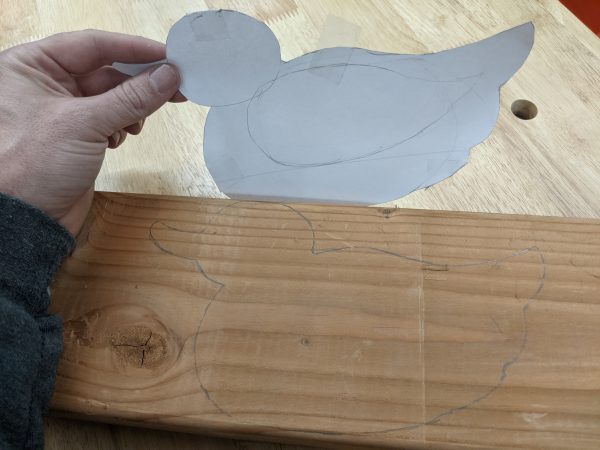
The duck looked easy enough. Sketch out a shape, trace it onto wood, jigsaw …

The wood was thicker than my jigsaw and skills could handle. Much sanding ensued.
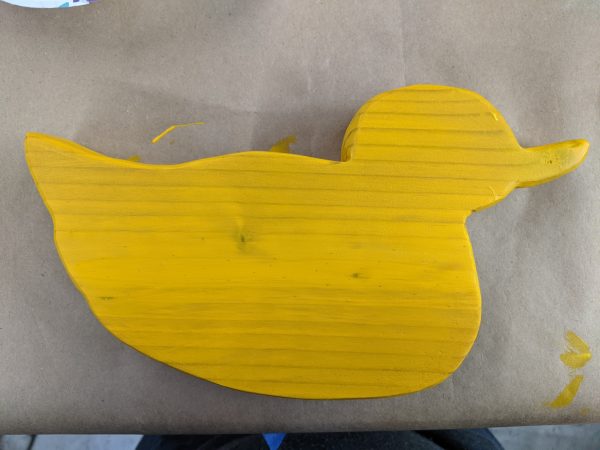
The wooden duck’s thirst for acrylic hobby paint could never be slaked, though I think this would have been good enough.
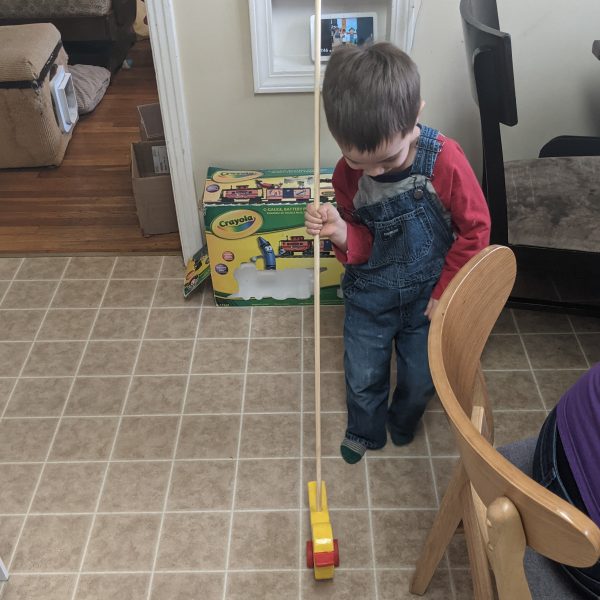
How long should the push dowel be?
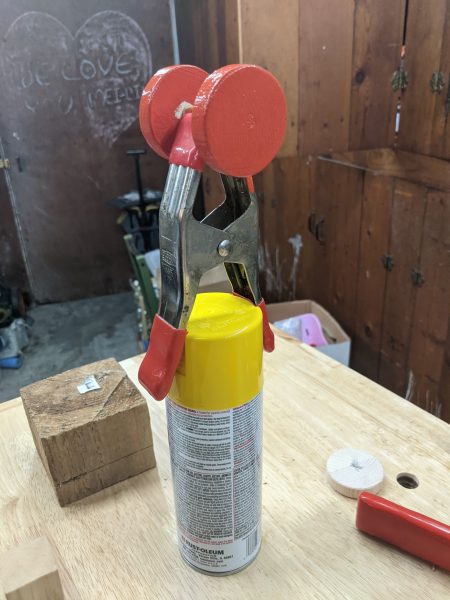
The spray paint provides a nice base for clamping the wheels by the axle as they dry.
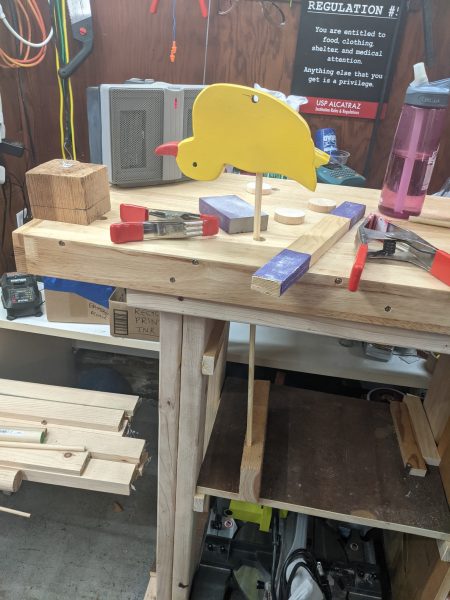
A bench dog holds the duck by the push dowel as a space heater helps the sealant out in Sunnyvale’s winter weather.

Sinking a hole in the handle for the push dowel. Fortunately, the client is not too picky about precision.

When all was said and done, it was the boys who really brought this project home!
The wheels are just large dowels, and the axle is straight enough to allow a slight wobble. As this was being built for my younger son I gave him the option of push toy or pull toy. He opted for a push toy, and I made the push stick about the right size for him.
Feedback Welcome
Link:
https://dannyman.toldme.com/2021/02/05/two-billion-humans/
Here’s a bit from an interview I enjoyed with Eileen Crist from the December 2020 issue of The Sun magazine, which you can read online. I appreciate that folks have done the math to figure out what a good population would be and how we could very reasonably get there. This would be an effort across generations, and who knows what will really happen anyway? We can all chip into a vision that we ourselves will never see.
Tonino: You said earlier that there are approximately 7.8 billion humans on the planet. What would be an ideal number of humans?
Crist: Many analysts are thinking of a provisional goal of around 2 billion. This figure is for a human population enjoying roughly a European standard of living, sustained by organic food production, and eating far less fish, meat, and animal products than the average Western consumer.
Of course, there is no “optimal” population number in an absolute sense, because a lot depends on the level of consumption people gravitate toward, their dietary choices, and unknown variables having to do with technological developments. But 2 billion is more optimal than where we are now and where we are headed. Two billion is what the global population was about a hundred years ago. It is a big-enough number to enable a connected global civilization to continue, with achievements in the sciences, humanities, technology, and so on. In other words, 2 billion can sustain a lively “conversation of humanity.” But it’s a low-enough number to enable the substantial protection of nature that we are discussing.
According to Cornell agronomist [the late] David Pimentel and his colleagues, 2 billion people is the estimated number that can be sustained on organic, diversified, mostly regional agriculture, with farm animals living on the land and people eating a mostly plant-based diet. This way of eating would not only be wholesome for people but good for the planet and for all other animals as well.
You might say: “Fine, 2 billion sounds good, but how do we get there?” We get there by fast-tracking two important human rights: One, full gender equity and schooling for all girls, through at least secondary education. And, two, affordable and accessible family-planning services for all. If we could bring the global fertility rate — voluntarily: I do not support coercion of any kind — to an average of one child per woman, the human population would start to approach 2 billion within four generations.
Tonino: The ecophilosopher Arne Næss said that he was pessimistic about the twenty-first century but optimistic about the twenty-second. How do you think about the future?
Crist: What Næss meant, I think, is that in the twenty-first century there will be a reckoning with how we’ve lived, what we’ve done to the planet and ourselves, and that reckoning will set in motion an awakening: a different way to go about things, a different relationship between Earth and humanity. It’s quite possible that things will play out that way — get bad, then better. In some respects it’s an optimistic prophecy. But obviously there’s no guarantee that the future will follow this trajectory. We don’t even know where we are with respect to climate change. If runaway heating happens — or a nuclear war or some other unimaginable disruption — this trajectory that Næss outlines will be impossible.
Feedback Welcome
Link:
https://dannyman.toldme.com/2021/02/10/democracy-and-insurrection/

I caught the opening of the impeachment trial today. The video from the House Impeachment managers was harrowing and damning. As a friend said last night, the US Capitol is sacred ground. Then Trump’s lawyers got up and rambled aimlessly. Bargain bin guys who came in unprepared to defend a guy who incited a mob to try and kill Congress. I wanted to feel that the case was so one-sided and the defense such a sham that the Senate would see through it and convict him and set a precedent that the United States will not tolerate anyone trying to take the government by force but I know better.
President Trump doesn’t need any defense better than a farce because we all know exactly what will happen. A majority of the Senate, all the Democrats, and some Republicans will vote in favor of Democracy. But not enough. Republicans are loyal to their party. Their Fascist will run again. He’s got a lot more charisma than Ted Cruz.
When the Insurrection happened on January 6, I was impressed that Congress picked themselves up, dusted themselves off, and got back into session. I watched until they certified the vote. Every time the objections to the count were withdrawn for lack of Senate support, I cheered, and for the few hours that objections were required to be heard, I rode it out. Congress certified the vote towards 3 am in Washington, and I counted it fortunate that I only had to stay up towards midnight in California. I explained that as a SysAdmin, when the system crashes and people get upset, I feel like I need to keep an eye on the systems as they get back to normal.
I feel optimistic that Joe Biden could well turn out to be a great President. He’s got a lot of experience, a lot of rapport, and the challenges are substantial. I also feel dread that our flirtation with autocracy is only going to get worse.
Feedback Welcome
Link:
https://dannyman.toldme.com/2021/08/03/welcome-back/

A few months back, everyone was talking about what it was like a year ago to enter the Pandemic. I never was much for that kind of nostalgia. I’ll say the Shelter in Place order came in on a Saturday and the boys cried because it meant their birthday party on Sunday was completely canceled after all. That’s metaphor enough to last me a few years.
I remember that early on, someone asked how long: 6-8 weeks? I suggested that we were looking at 12-18 months because that’s the fastest we could conceivably develop, test, approve, manufacture, and distribute vaccines. I didn’t want to be a bummer so I didn’t bring up my pessimism much. Everyone figured a couple of months.
When things opened up in June, I got us a plane trip to Chicago. We had a big party planned the year before that couldn’t happen, and the youngest had never been, and the older kid I really owed a fireworks show. I had worried about the logistics and whether everyone would have a good time but the trip was so immensely enjoyable.
“We need to have our fun now, before the next wave,” had been my thinking. Of course, I was thinking of the vaccine-resistant strain that has yet to evolve, not the wave that is currently hitting the vaccine-resistant population.
During the Pandemic, my employer figured out that our staff are really productive working from home, and the lease was up on the office so we took the opportunity to downsize. The new location is right next to the train, and on days when family obligations allow, I really love taking the train to the office. I think this is a pretty ideal commute: walk fast to the station, sit down, read a book, walk sorta fast to the office. Some light exercise for the body and relaxation for the mind built right into the schedule.
Lately, I’ve been coming into the office any chance I can get. As I explain, I really like working from home, and I have a good setup, but it also reminds me of the Pandemic, which I am happy to forget. Yesterday came the Public Health Order that we now wear masks in the office. I am here today and tomorrow. There is definitely a feeling of setback.
We had the technology and the money to free our country of the Pandemic this year. What we lacked was a cultural consensus that rolling up sleeves and getting a shot was worth everyone doing. I think this is just a warm-up for how our century will go. The planet is on fire again this year. Portland fried like it was Death Valley. We have, so far, been lucky in the Bay Area. No orange skies, no smoke … I haven’t run the air conditioner in weeks. Just the ongoing drought. This year, the Salmon fry will all be cooked in their natal streams.
We never took action to prevent the Climate Catastrophe beforehand. Even now, we have tools like electric cars and induction stoves and any number of ways we can reduce our Carbon emissions and … we make excuses. The new budget stimulus adds some money for public transportation, but the big money is in building more roads. In a few years, maybe, they say, there will be a few more electric cars you can buy. (And don’t bring up bike lanes.) The power grid is getting cleaner, at least.
I had a cheeseburger for lunch.
Feedback Welcome
Link:
https://dannyman.toldme.com/2021/09/07/aqi-o-stat/
We bought our home in Northern California in 2012, which was great timing because that was about the last time after the mortgage crisis that we could reasonably afford a home, at a mere $605,000. At that time, the home had a floor/wall furnace from 1949 that had a hole that made it a carbon monoxide risk. We upgraded to central heating shortly after. Guys came out and ran ducts all over the attic and hooked them all up to an efficient gas furnace with an air filter. Topped it all off with a shiny Nest thermostat. It gets chilly out here on winter nights, and it used to be only a few days in the summer that anyone needed air conditioning, at which point you go to the office during the week or to the mall on the weekend.
In 2016 I added an air conditioner to the system. The local contractors seemed not quite comfortable with heat pumps, and the furnace was new, and we only run the air conditioner, well, now maybe a total of a few weeks each summer. A major construction project across the street involved asbestos mitigation, and we were having a baby, so the ability to shut the windows on bad days had some appeal. (I later gifted our old box unit AC to another expectant couple who had concerns with construction dust.)
Most of the time, we enjoy having windows open, day and night. Most of the time, our climate is blessedly mild—most of the time. The past few years have had a lot more smoke from all the fires in California. 2020 had an apocalyptic vibe when the plague was joined by a daytime sky turned orange. Shut the windows, run the AC, praise the air filter in the HVAC. For the Pandemic, I also set the air to circulate 15 minutes every hour during off-peak energy hours. (We’re on a Time-of-Use plan.) The idea is that if we had COVID-19 in our air, we would filter some of it out and help improve our odds.
This year has been less awful. The winds have been mostly blowing the fire smoke from the hellscape experienced elsewhere in the West, away from the Bay Area. As a result, AQI has stayed mostly under 200. But as I had gotten back in the habit of checking purpleair.com to figure out if the windows need shut, I got curious to better understand the air quality inside our house, so I ponied up $200 for an indoor monitor. It has a bright LED that changes color based on what it measures, and the boys think that’s a pretty great night light.
My first revelation was that indoor AQI was spiking overnight, starting around midnight. Since I first installed it near the dishwasher, I figured that was the culprit. After a week of A/B testing, I had ruled out the dishwasher and figured out when the wife goes to bed, she likes to run a humidifier, and the water droplets in the air can look like pollution to a laser. Mystery solved!
The other thing I noticed while keeping an eye on purpleair.com to see if it was time to shut the windows is that our indoor AQI would tend to have a lower (better) score than outdoor sensors nearby. That’s good news. Zooming in, I could see a jaggy pattern where the AQI would drop when the furnace fan circulated our air through the MERV 16 filter in the attic, then it would spike back up. The upshot is that we could have open windows most of the time and cleaner air inside the house, but how to run the fan on an efficient schedule?
Well, it is tied to a thermostat … I could implement an “AQI-o-stat” with a Python script that scrapes the AQI reading and tells the Nest to run the fan. The script took about 3 hours to write. 10 minutes to scrape purpleair.com, 2.5 hours to figure out Google/Nest’s authentication API, and 20 minutes to figure out how to set the Nest fan. The authentication part took only 2.5 hours because Wouter Nieworth posted a bunch of helpful screenshots on his blog.

I implemented the “AQI-o-stat” on the afternoon of Sep 3, at which point CatHouse A now keeps AQI around 60 or below, while the neighboring Zinnias outdoor sensor reads in the low hundreds.
There was some tweaking, but I now have a Python script running out of cron that checks the indoor AQI, and if it is above 50, it triggers the timer on the fan. I started polling at 15-minute intervals but found 5-minute intervals made for a steadier outcome. The result is that we can leave the windows open, and the indoor air quality hovers around 60. One less thing to worry about. (There are plenty of things to worry about.) I have been thinking that, in the “New Normal” (which really means there is no “normal” because the climate systems have been thrown into turbulence) that having an air sensor as an input to your smart thermostat will probably just become a standard feature.
So, “hello” from the near future, I guess.
Feedback Welcome











